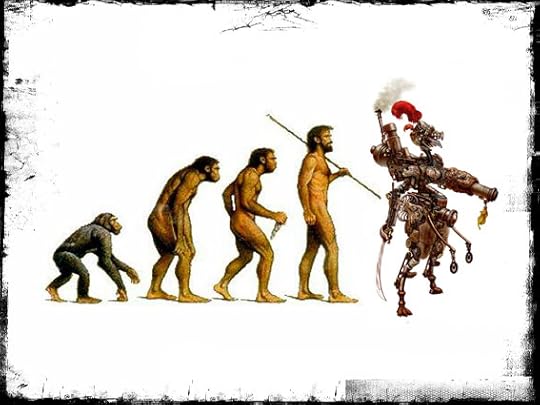A History of Steampunk, Part 5: Evolution
In Part 4 (if you're wondering how long can I draw this thing out for, believe me, I'm wondering the same thing) we talked about Steampunk's naming day, the first writers to be associated with the handle, and its nebulous links to cyberpunk. Today, I'll discuss SP's development through the 90's and 2000's, and how it evolved into the non-stop hit-machine we know today.
Steampunk had been seeing a resurgence in the world of film for years by the time it actually got itself a bona fide handle. Spielberg's Young Sherlock Holmes and Terry Gilliam's (of Monty Python fame) The Adventures of Baron Munchhausen are good mid-80's examples. Spielberg even headed back to the trough for seconds and brought us a flying, time-traveling steam-train (and a healthy serve of bustles, goggles and corsets to boot) in the third Back to the Future film in 1990.
At the end of the 90's, we saw the birth of what is probably the most universally reviled example of Steampunk to date – the film adaptation of the 60's TV series: Wild, Wild West. It should be noted however, that even though most serious Steampunk aficionados will hiss like some penny-dreadful vampire at the mention of the film's name, I personally guarantee that this movie will still be cited in almost every "what is Steampunk" conversation you'll hear. Why? Because is captures the notion of Steampunk (historical setting, with anachronistic technology) perfectly. It's just a pity about the… well… it's a pity about everything else in this entire film, really…
Meanwhile, back at the book-cave, Philip "IH8 C.S Lewis" Pullman published The Golden Compass in 1995 to critical acclaim and some very stern looks from the right-wing christian establishment. In the same year that Wild, Wild West hit movie goers like a diagnosis of rectal cancer, Alan Moore began his League of Extraordinary Gentlemen graphic novel series. League (no, not the film, ignore the film, it never happened) took famous characters from Victorian literature (Alan Quartermaine, Mina Harker, Captain Nemo, et al) and pitted them against sinister villains in a steam-powered Britannia, quickly becoming one of the greatest successes of Moore's career, and catapulting the concept of Steampunk into the limelight. It should also be noted that an extraordinary amount of manga and anime created with a Steampunk aesthetic (Nausicaä of the Valley of the Wind, Castle in the Sky, Howl's Moving Castle, Steamboy, Fullmetal Alchemist) began to be translated into English around this period. In the early 2000's China Miéville began his Bas-Lag series (Perdido St Station, The Scar and Iron Council), a fantastical series in which magic, arcane technologies and alien species were combined to roars of approval from readers and Literatii alike.
Including me. Goddamn, I love China Miéville in the pants.
Bas Lag, League and the anime bomb emerged just as the internet was becoming an intrinsic part of modern society, enabling people with common niche interests to cross the geographical divides that might otherwise have prevented those interests catalyzing into something more formidable. And damn that was a long sentence…
With SP spreading across the internet like some kind of corseted, goggle-wearing virus, more and more sub-cultures began to hook their wagons to the star. Goths, Punks, Rivetheads, Japanese Lolitas and Aristo's all found some kind of common ground, dragging in their musical tastes and social views into what began to evolve beyond a simple genre of fiction and become a scene. And beyond that, lurked the moniker that many of the more vocal and prolific SP community members seemed to be striving towards like so many clockwork powered Robots of Doom:
The Movement.
Next Week – A History of Steampunk Part 6: Conclusion












